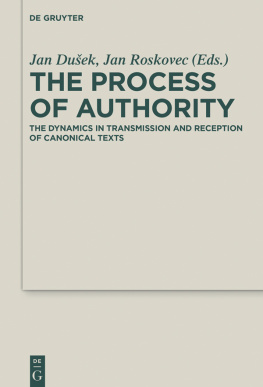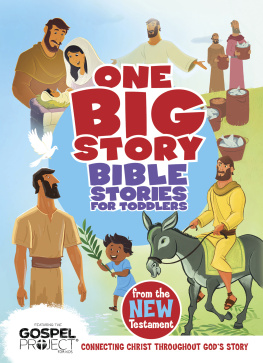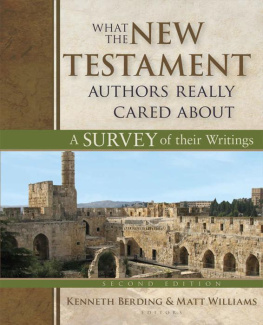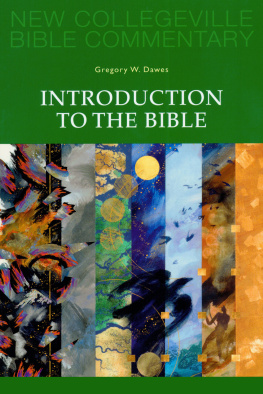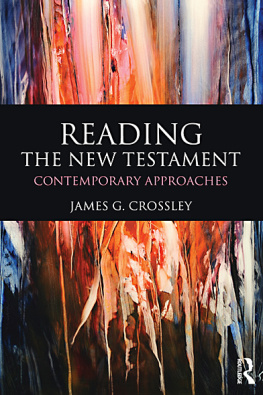First Mariner Books edition 2015
Copyright 2013 by Hal Taussig
All rights reserved
For information about permission to reproduce selections from this book, write to Permissions, Houghton Mifflin Harcourt Publishing Company, 215 Park Avenue South, New York, New York 10003.
www.hmhco.com
The Library of Congress has cataloged the print edition as follows:
A new New Testament : a reinvented Bible for the twenty-first century combining traditional and newly discovered texts / edited with commentary by Hal Taussig ; with a foreword by John Dominic Crossan.
pages cm
Includes index.
ISBN 978-0-547-79210-1 (hardcover)
ISBN 978-0-544-57010-8 (pbk.)
1. Bible. N.T.Criticism, interpretation, etc. 2. Christian literature, EarlyHistory and criticism. I. Taussig, Hal, editor of compilation.
BS2361.3.N467 2013
225.5'208dc23 2012046359
Cover design by Hsu and Associates
Cover illustration Dae Yoo
e ISBN 978-0-547-79211-8
v2.0815
Photograph of Papyrus P52 courtesy of John Rylands University Library of Manchester.
Translation of the traditional New Testament (except for the Letter to the Colossians) from the Open English Bible, with permitted revisions by Hal Taussig. Courtesy of Russell Allen, holder of copyright, and under Creative Commons Zero license, http://creativecommons.org/publicdomain/zero/1.0.
Translation of the Acts of Paul and Thecla, the Gospel of Mary, the Gospel of Truth, the Letter of Paul to the Colossians, the Letter of Peter to Philip, the Prayer of the Apostle Paul, and the Prayer of Thanksgiving by Celene Lillie. Permission granted to Houghton Mifflin Harcourt. All rights reserved.
Translation of the Odes of Solomon by Elizabeth Ridout Miraglia. Permission granted to Houghton Mifflin Harcourt. All rights reserved.
Translation of the Gospel of Thomas by Justin Lasser. Permission granted to Houghton Mifflin Harcourt. All rights reserved.
Translation of The Thunder: Perfect Mind by Hal Taussig, Jared Calaway, Maia Kotrosits, Celene Lillie, and Justin Lasser. Permission granted to Houghton Mifflin Harcourt by Hal Taussig.
Translation of the Secret Revelation of John by Karen King. Reprinted by permission of the publisher from The Secret Revelation of John by Karen L. King, pp. 2881, Cambridge, Mass.: Harvard University Press, Copyright 2006 by the President and Fellows of Harvard College.
Introduction to the Secret Revelation of John by Karen L. King. Permission granted to Houghton Mifflin Harcourt. All rights reserved.
For
Robert Funk, who first thought about A New New Testament
Candice Olson, who seized the idea with passion
Russell Allen, who handed the New Testament to the public
Foreword
T HE TRADITIONAL NEW TESTAMENT was already established by the end of the fourth century. The pressing question, then, is why suggest A New New Testamenteven with A, not Theafter a millennium and a half have passed?
It is notemphatically notthat all or most of what is inside that traditional New Testament is bad or deficient while most or all of what is outside it is perfect and preferable. But why, then, entitle this book A New New Testament rather than, say, Other Early Christian Texts?
For myself, I see two reasons why this particular book and this precise title are necessary and needed. I put them to you as challenges, maybe even as principles, and in aphoristic format to facilitate memory and thought.
My first reason is a rather simple redundancy with regard to the traditional New Testament: to know what is outside it, you must know what is outside it. In other words, it is a matter of adult education because education affirms options while indoctrination denies them. Since that is probably obvious, I offer only one example.
You open your standard New Testament and find four versionsfour according tosof the gospel. Stay inside that volume and you could easily conclude that all existing versions had been gathered and presented. Go outside to A New New Testament and you realize immediately that many other versionsand indeed types, modes, and stylesof gospel were availableand avoided.
What you do with that knowledge, and how you judge between texts in or out, is a separate issue. But you should know that all gospel versions were not taken, that a selection was made, that some were accepted and others rejected. And that knowledge is, to repeat, an education, and education is about knowing options.
My second reason for A New New Testament is that, with regard to the traditional New Testament, to know what is inside it, you must know what is outside it. I offer you two examples of that principle, two cases to illustrate that, even if you are exclusively focused on the traditional New Testament, you cannot do so. You must know what was rejected to understand what was accepted. And why, and when, and where. Both of my examples involve images to remind us that we do not live in a world made only of wordsbe they old words or new words.
A first example. High on the northern slopes of the Blbl Dai, off the mid-Aegean coast of Turkey, is a small flat clearing on the hillside with a stone frontal for a small doorway. This opens into a cave carved in antiquity to an eight-by-eight-by-fifty-foot passageway shrine called the Grotto of St. Paul by excavators from the Austrian Archaeological Institute in the 1990s. Beneath later plaster they found frescoes from around the year 500 CE .
On entrance, to your immediate left, is a scene almost completely obliterated but still residually recognizable. A standing man holds aloft a large knife above a much smaller kneeling figure whose tiny feet are about all that has been left by time the destroyer. It is, of course, the story of Abraham and Isaac from Genesis 22.
You turn next to the fresco on the wall at entrance right. It is much better preserved, with the upper half almost totally untouched by decay. But it is not a scene you recognize from either the Hebrew Bible or the Christian New Testament. Of its three figures, the central one is definitely Paulosbald-headed, double-goateed, named, but not haloed. He is seated and reading from an open book on his lap (A New New Testament, maybe?). His right hand is raised in the teaching-and-blessing gesture of Byzantine iconographyfingers separated into two and three, for the two natures in Christ and the three persons in the Trinity.
To viewer right of Paul is a standing woman named Theoklia, coiffed as a matron by the veil around her hair. She is slightly taller than Paul, and her right hand is raised in a gesture identical to his. But her dignity, importance, and teaching authority are all negated by having her eyes blinded and her hand scraped and burned off the wall (not iconoclasm, by the way, as only her eyes were obliterated).
To viewer left of Paul is a second female figure iconographically designated as a nubile virginher hair is unveiled and she listens to Pauls message, not with others out in the open but from a window in a red-brick house that encases her completely. Her name, Thekla, is stillbut barelydiscernible to the left and right of her head.
Those three figures present a scene that summarizes a story which you, as viewer, are supposed to recognize. But you do not do so because, whatever about Paul, neither Theoklia nor Theklaand Thekla, by the way, is the focal point of the frescois anywhere in your traditional New Testament. The textual version of that dramatic scene is in the Acts of Thecla, which is still extant as the opening chapters of the second-century Acts of Paulhence it is often called the Acts of Paul and Thecla.
Next page

